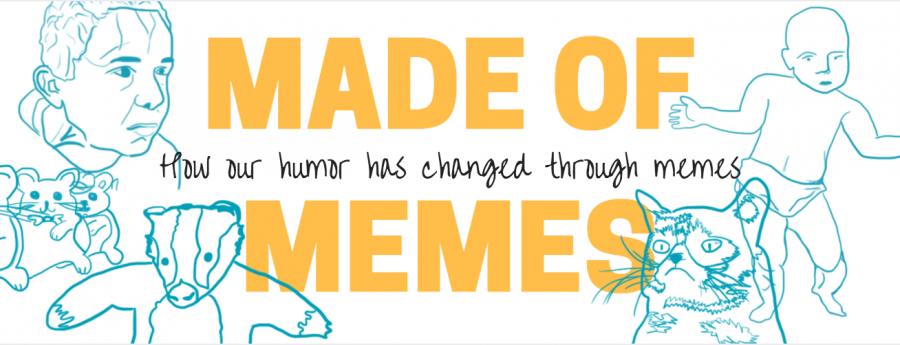Additional reporting by ZaZu Lippert and Avni Prasad.
If you’re reading this, memes are dead. Because we, as a news organization, are doing the inexcusable: we are writing a news story on them. And according to Class of 2016 alumnus Zarek Peris, a meme that has been in the news is a meme already in its grave. Like a joke that has to be explained, a deconstructed meme is counterintuitive, because it’s fundamentally based upon its ability to relate with individual experiences.
The way we express our humor in the modern day has evolved. While we still do love telling cheesy jokes with slapstick punchlines or planning out elaborate pranks, memes have annexed the otherwise uncharted territory of internet humor.
So here is a toast to memes — those indescribable, indestructible, soon-to-fade-from-the-collective-internet-conscience Bibles of pop culture. Pantheons of that peculiar brand of online humor, they stand testament to the fast-paced brilliance of the internet.
Defining a meme
The term meme first appeared in “The Selfish Gene”, a book in which author Richard Dawkins explores evolution. Dawkins, an evolutionary biologist, stated in the book that the key to understanding life is not by looking at “gels and oozes,” but by looking at information technology.
He proposed that the evolution of life is centered around replicators, machines that continuously churn out content. The human brain began as the main replicator, allowing it to repeatedly churn out ideas through books, music or art. But now a new replicator has emerged, and while Dawkins still believes the idea itself has yet to fully develop, this replicator was famously termed, by Dawkins, as “the meme.”
“Memes propagate themselves in the meme pool by leaping from brain to brain via a process which, in the broad sense, can be called imitation,” Dawkins wrote. “They compete with one another for limited resources: brain time or bandwidth. They compete most of all for attention.”
Memes, according to Dawkins, are ideas and behaviors spread from person to person within a culture. On the internet, memes first appeared as a term across various forums and message boards as early as the late 1980s. But it wasn’t until 2011 when the popularity of memes exploded. According to Google Trends, during October of 2010, the term meme had only reached four percent of its peak popularity. By April 2012, that number had risen to 26 percent, and in the following years that number continued to grow
Peris defines memes as a joke contained to a single work. It can be practically anything: a text, a phrase, a picture — but it must remain individual and self-contained.
“When you see something repeated over and over especially on social media you become infused,” Peris said. “Like why do you like your music? Memes are a style of comedy, something that you listen to over and over again, and it’s something that used over and over again. When you’re on social media you inevitably will see them.”
The first meme that Peris himself remembers seeing was the one that is colloquially known as the ‘bed intruder’ video. It sparked his love, and passion, for memes. His exposure was originally concentrated to the online message board Reddit, but eventually, the memes he saw started appearing on other social media channels such as Facebook, Twitter and Instagram. And so Peris followed.
The humorous images, videos and text spawned discussion with his friends in his Drama class. And so, during the summer of 2015, Peris’ friend and Class of 2016 alumni Zach Sanchez, suggested that they make their own memes.
“[Sanchez] was really interested in graphic design, so naturally [while he was] creating images, we were talking about memes, [and the discussion] was all ‘we should start a page,’” Peris said. “[Sanchez] spearheaded it when we started the page.”
Peris made his first meme on a Windows Vista computer. He didn’t have Photoshop, so he used an alternative: Microsoft Paint. It was the first of many memes he’d make.
And so, in the summer of 2015, after two friends banded together and decided to create their own memes, the Facebook page “Squidward de la Future: Chrome and avant-garde memes from the 3000” was born.
The page, which has reached over 50 likes, is an ongoing hobby for the two of them, and has expaded to include other page administrators. Unlike other meme pages, which Peris explains can be rehashes of already pre-made memes, most of Peris’ memes are original. His meme style, as he explains, is taking a common trend and warping its description to be slightly off.
“Like the [meme] I [posted] of Thomas Jefferson– the meme is on the slightly off,” Peris said. “I’ve taken a common trend– like absurdist comedy–and combined with the fact it’s an inside joke.”
Memes, according to Peris, have allowed humor to become more accessible, like one gigantic inside joke shared across large online communities. But while the internet has given humor a broader reach, it has also kept these jokes contained to their own niches of the internet, keeping an air of exclusivity.
“I mean it’s not really a choice that you have. It’s a side effect of being on your social media,” Peris said. “Once you get into meme culture, you’ll like follow a bunch of different pages or whatever platforms you use, because it’s all a cycle, right? As soon as a news source does an article on the meme it’s dead. Like that’s the end of this life cycle. Boom! Killed. The end. Got the sword. Got the axe.”
THE ONE WHO’S OBSESSED
For many people memes are important tools of social interaction, they enjoy “tagging” their friends on social media platforms such as Instagram and Facebook. For Sophomore Varshini Srikanthan her awareness of memes stemmed from the creation of her Facebook account two years ago.
“I just remember my friends would just keep tagging me in them and I’m like ‘Ok these are funny’,” said Srikanthan.
Now Srikanthan is often described by friends and classmates as obsessed with memes, something which she feels has made her and her friends’ sense of humor both darker and drier. But despite her love of memes Srikanthan finds that their humor can often be divise, sometimes taking the joke a step too far.
“I think it kinda divides us into two types of people,” Srikanthan said, “Like people who are oversensitive and people who say whatever they want and make jokes about things that shouldn’t necessarily be talked about.”
She recalls an instance of seeing a Hitler meme online and that made her feel very unsettled and uncomfortable.
“It’s like you’re taking one step too far,”Srikanthan said “And to a point it’s kind of funny, but you see stuff like that, and you’re like ‘Whoa.’”
THE MEME WALL
It’s dubbed the “meme wall.” The eastern door of A111, its wooden frame plastered with creatively Photoshopped images, all stuck on with strips of clear scotch tape. The common subject of each meme is illuminated clearly under the bright fluorescent lights: history teacher Cody Owens’ face, Photoshopped and edited with the blocky white text and border characteristic of most memes.
It began as a simple prank. A quick search of “Cody Owens” on the MVHS website had brought up his picture. The next day saw the image blown up and printed out, seven copies to be exact, and pasted to the surfaces of his room. In the few minutes Owens had taken out of tutorial to go to the restroom, JV Football player Shakthi Elangovan had taped up the images to the walls. Then awhile later, after the JV team defeated Lynbrook, the first meme appeared, pasted to the door of his classroom without an explanation. From there it snowballed and soon not only the football players but Owens’ students as well were making their own memes.
Each photo used is taken either under his nose before class, during tutorial or taken from the picture published with the staff list on the MVHS website, before then being used to create a customized meme. The students do not attempt to hide their antics from their teacher, walking up to him during these breaks and taking photos as he watches in confusion.
“[Students will] just walk right up and I’d be like ‘what are you doing?’ and then suddenly their phone’s out and they just snap a photo [to use for the meme],” Owens said. “There’s one where I have a ‘Welcome to the Party’ poster, and they just replaced all the communist figures heads with my head. There can be bad ones out there, I’d be afraid to see those, but otherwise they are cool — they are something fun.”
While Owens is unsure why students are so comfortable with sharing the memes they make about him, he knows other teachers also have had memes made of them. He believes it’s the close relationships he has with his students and the football players that allows them to feel comfortable with making these kinds jokes with him Most of the memes were created when he began to build that foundation of trust between his football players throughout the season, trust that has allowed his students to be open with him about their antics.
“Sometimes I’d just turn around and see a student taping a meme to a door and that’s how that started,” Owens said. “They have one where I am sitting back in a chair and it says ‘Why am I a coach I could’ve been a model’? That one is probably my favorite.”
However, for his student Sidartha Murthy, the answer is clear.
“[Owens] seems really approachable and I feel like a lot of teachers almost feel like omnipotent beings, but Mr. Owens seems really down-to-earth — someone you could talk to,” Murthy said. “We come in here, he has the March Madness games on, we play X-box, 2k, but then we also come into class and we also learn a lot and we do really well in this class so it’s a good balance between learning and fun.”
And for sophomore Rithvik Madhdhipatla, Owen’s approachability combined with his nature to say quoteworthy tidbits is exactly why Owen’s makes a perfect target for their memes.
“He says a lot of funny stuff during class — we pretty much use whatever he says against him,” Madhdhipatla said. “They’re mostly something that happened in class, something he teaches. He did a whole lesson on government surveillance and how we’re becoming like a dictatorship, and that’s [when we started] NSA memes and Illuminati memes. He’s a conspiracy theorist.”
Peris explains that it’s these communal trends and inside jokes which make memes work. The current, repeated ideas were produced by those who are and who want to be “in” on the inside joke.
“It’s like an inside joke, so you want to follow a common trend that people know,” Peris said. “Whenever you post a meme it’s gotta be something that’s current and trendy that you see within the community, that you see other people posting.”
And while memes are commonly expressed through social media’s viral nature, it hasn’t replaced older expressions of humor. Instead, it’s become an enhancement.
In fact, for Peris, memes are a form of expression that make the world more connected than it was before. Their low barriers to understanding, infectious nature on social media and the explosion of online pop culture have allowed for them to take such prominence online.
“You have people that have difficulties in social situations always on these online communities. You have people that are completely comfortable with social situations also on these online communities,” Zarek said. “The reach of a meme is even broader than that of a traditional inside joke. It [hasn’t] exed out previous humor — it’s just given a platform for it.”










